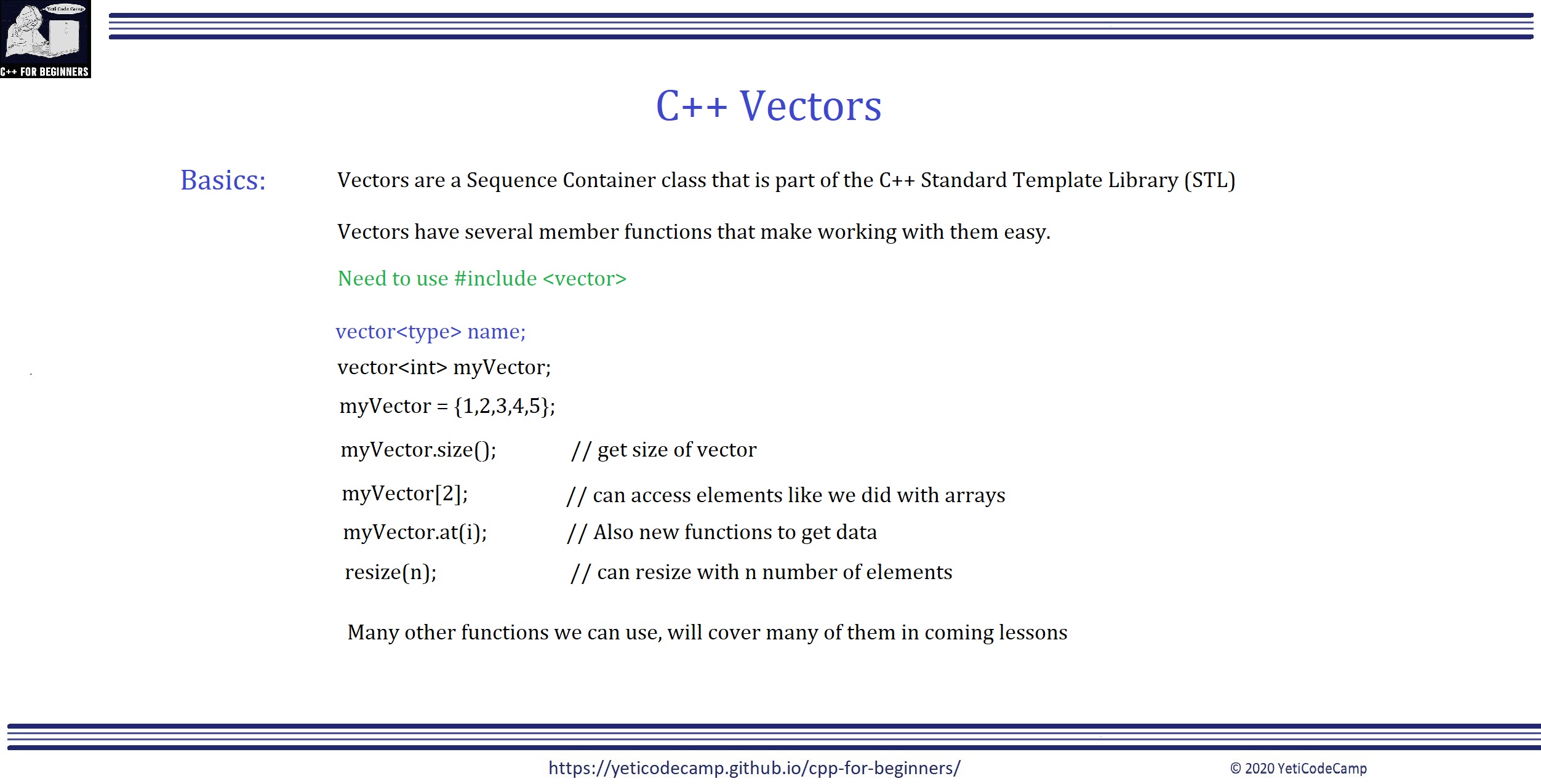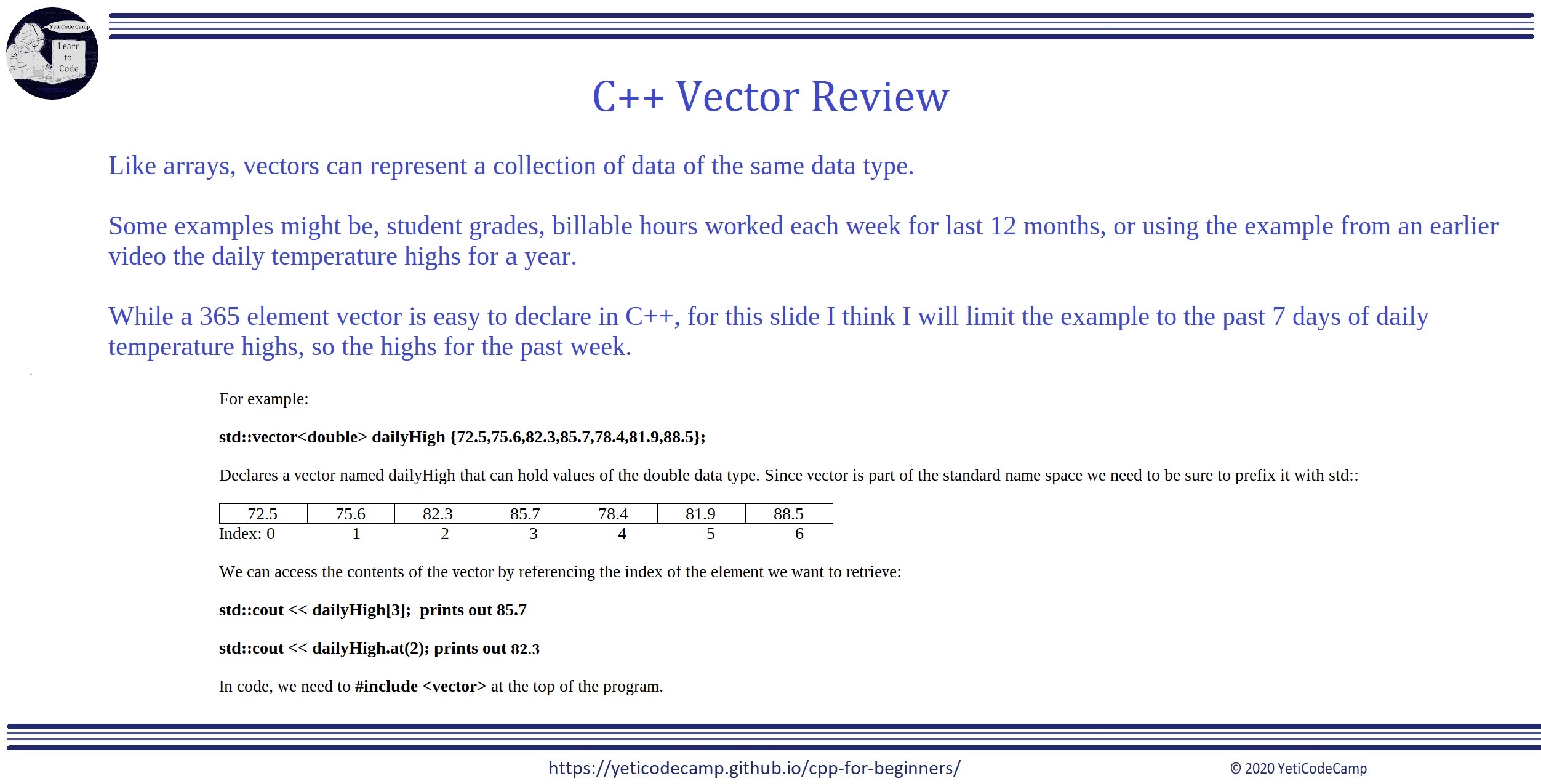This is the companion page for the C++ for Beginners Series
Video 11 – C++ Vectors
While we were introduced to vectors in the last video, since this one is dedicated strictly to vectors I thought a quick review was in order. This also helps anyone just coming in straight to this video.

Vectors are part of the C++ Standard Template Library or often referred to as simply STL. They are also part of the standard namespace, so you need to prefix the keyword vector with std:: as we do with cout.
Vectors have member functions available to them to make working with them easy.
| Function | Description |
|---|---|
| assign() | Assigns new values to a vector replacing any existing elements. |
| at() |
Returns the value of the element specified. |
| back() |
Returns the value of the last element in a vector. |
| begin() |
Returns an iterator to the first element in a vector. |
| capacity() | Returns the current memory allocation of a vector. |
| cbegin() |
Returns a const iterator to the first element in a vector. |
| cend() |
Returns an iterator to just beyond the last element of a vector. |
| clear() |
Clears (erases) the contents of a vector. |
| crbegin() |
Returns a const iterator to the first element in a reversed vector. |
| crend() |
Returns a const iterator to the end of a reversed vector. |
| data() | Returns a pointer to the first element in the vector. |
| emplace() |
It inserts a new element just before the position specified. |
| emplace_back() |
It inserts a new element at the end of a vector. |
| empty() |
Boolean check if the vector is empty. |
| end() |
Returns a iterator to the end of a vector. |
| erase() |
Removes one or more elements from a vector. |
| front() | Returns the value of the first element in a vector. |
| get_allocator() | Returns an object to the allocator class used by a vector. |
| insert() | Inserts one or more elements into the vector at the specified position. |
| max_size() | Returns the maximum length of the vector. |
| operator[] | |
| operator= | |
| pop_back() | Deletes the last element of a vector. |
| push_back() | Adds an element to the end of a vector. |
| rbegin() | Returns an iterator to the first element in a reversed vector. |
| rend() | Returns an iterator to the end of a reversed vector. |
| reserve() | Reserves a minimum length of storage for a vector object. |
| resize() | Specifies a new size for a vector. |
| shrink_to_fit() | Reduces the vector capacity by settings it to the current size of the vector. |
| size() | Returns the number of elements in the vector. |
| swap() | Swaps the elements of two vectors. |
Vectors are declared with the keyword vector, the data type of the elements, and a name. To be able to use vectors, be sure to #include <vector> at the top of your program.
We do not need to give it a size right away like we did with arrays. Vectors can be resized in memory as needed.
We can initialize vectors upon declaration like in this example:
std::vector<int> myVector = {1,2,3,4,5};
We can declare and initialize vectors at separate times, for example:
std::vector<int> v1;
v1 = {1,2,3,4,5};

We can create a vector to hold the daily high temperatures for the last year, month or week. Here is a simple example showing a vector holding 7 temperature values.
std::vector<double> dailyHigh {72.5, 75.6, 82.3, 85.7, 78.4, 81.9, 88.5};
We can access the contents of the array by referencing the elements index:
std::cout << dailyHigh[3]; //prints out 85.7
std::cout << dailyHigh.at(2); // prints out 82.3
Here is a complete example program that compile and will print out the example dailyHigh vector using a range-based for statement:
#include <iostream>
#include <vector>
int main()
{
std::vector<double> dailyHigh {72.5, 75.6, 82.3, 85.7, 78.4, 81.9, 88.5};
for(auto v : dailyHigh)
std::cout << v << " ";
std::cout << "\n" <<std::endl;
return 0;
}
prtVec()
Instead of writing out a bunch of cout statements to display the vector element values all the time, cluttering up the code, let’s utilize a function.
This is a perfect example of when to use a function, when you are going to repeatedly use a certain segment of code over and over again.
Here is the completed print vector function prtVec():
void prtVec(const std::vector<auto> &vec, std::string n="")
{
// Function takes 2 parameters, vector and optional name
if (n!="")
std::cout << n << " is: ";
for(auto v : vec)
std::cout << v << " ";
std::cout << "\n" <<std::endl;
}
Times Table
Final form of the timesTable() function. Remember to declare it above main with:
void timesTable(int x = 10, int y = 10);
Put the actual function definition below main:
void timesTable(int x, int y)
{
std::string title = "\n\nv4 Times Table\n\n"; // Initial title string with "\n" newlines for positioning
for(int i=0; i<((y / 2) -1); i++) // For loop iterating up to y columns / 2 and subtracting one.
title.insert(2, "\t"); // Insert a tab at index 2
std::cout << title; // Print the modified title (scaled according to columns)
std::vector<std::vector<int>> v4(x , std::vector<int>(y)); // Create a vector containing x vectors of size y.
for(int i=0; i<x; i++) // Standard for-loop to iterate through and fill vector elements with i*j
for (int j=0; j<y; j++)
v4[i][j] = (j+1) * (i+1); // Need to add one to account for 0 index
// Print out vector, just as we did for our arrays using range-based for statement
for(const auto &x : v4) // Iterate through "rows" or vector 'x' (there are 10 vectors)
{
for(const auto &y : x) // Iterate through "cols" or elements in vector x
std::cout << y << "\t";
std::cout << "\n\n";
}
}
